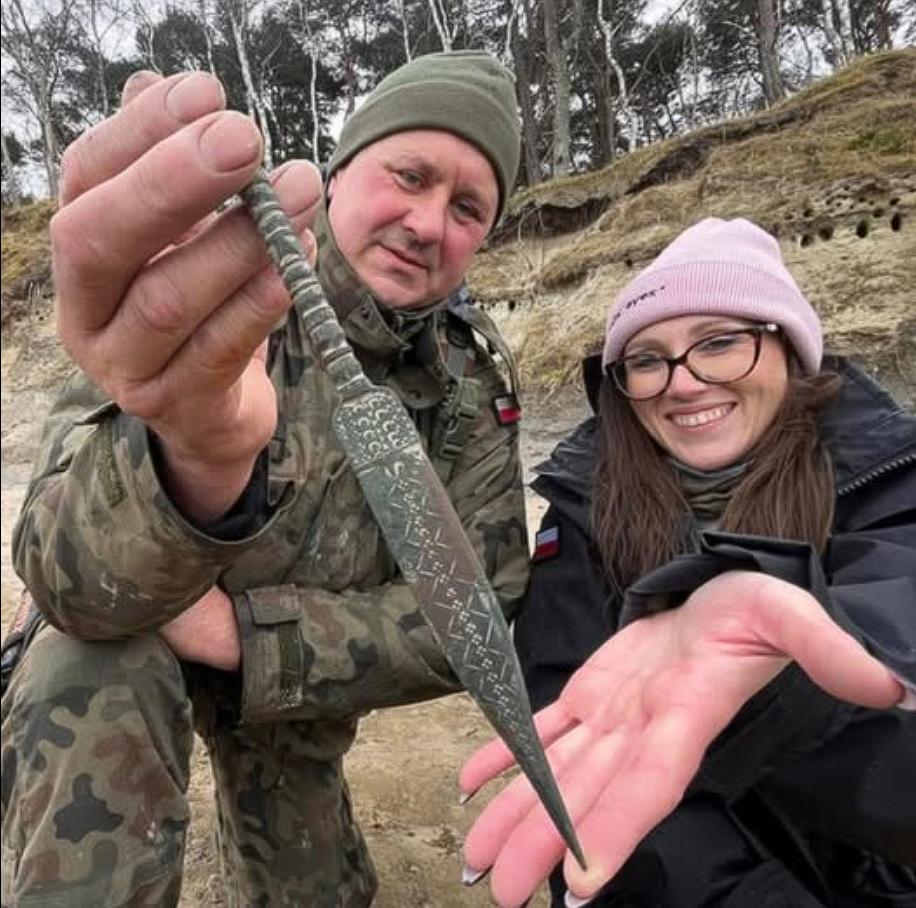A stunning archaeological discovery on a Polish beach has brought to light a 2,800-year-old dagger, a relic from the early Iron Age. Unearthed by metal detectorists, this intricately decorated artifact offers a rare glimpse into the Hallstatt period and the potential ceremonial practices of the time.
A Storm’s Revelation: The Dagger’s Discovery
- Beach Discovery: A Cliff Collapse Unveils History:
- A storm-induced cliff collapse on a Polish beach revealed a 2,800-year-old dagger, a significant find for archaeologists and historians.
- Metal detectorists Katarzyna Herdzik and Jacek Ukowski made the discovery, showcasing the vital role of citizen science in archaeological discoveries.
- This find, was a lucky accident, that has revealed much about the past.
- Hallstatt Period: Early Iron Age Artifact:
- The dagger dates back to the Hallstatt period of the early Iron Age, a crucial era in European history marking the transition to ironworking.
- This period is characterized by significant cultural and technological developments, making artifacts from this time highly valuable.
- The Hallstatt period, is an important part of European history.
- Exceptional Preservation: Intricate Decorations:
- The dagger, measuring 9.5 inches in length, is remarkably well-preserved, showcasing intricate decorations such as crescent moons, star-like crosses, and delicate engravings.
- These decorations suggest the dagger held ceremonial or high-status significance.
- The detail, on the dagger, is amazing.
Ceremony or Warrior: Unraveling the Dagger’s Significance
- Ceremonial Significance: Solar Cult Rituals?
- Experts believe the dagger may have held ceremonial significance, possibly linked to solar cult rituals, given its symbolic decorations.
- This theory suggests the dagger was used in religious or ritualistic practices, providing insights into the beliefs of the time.
- The symbols, on the dagger, point to this theory.
- High-Status Object: A Wealthy Warrior’s Weapon?
- Alternatively, the dagger’s fine craftsmanship and symbolic design suggest it may have belonged to a wealthy warrior.
- This theory aligns with the dagger’s ridged handle, indicating it was a high-status object.
- The quality, of the dagger, points to this theory.
- Further Study: Materials and Origins:
- The artifact has been turned over to the Museum of the History of Kamien Land for further study.
- Specialists are examining the materials and origins of the dagger, investigating whether it was produced locally or imported from southern Europe.
- More research, is needed, to unlock the daggers secrets.
A Glimpse into the Past: Displaying History
- Museum Display: A Rare Artifact:
- Once research is complete, the dagger will be displayed in a Polish museum, offering the public a rare and fascinating look into early Iron Age life and artistry.
- This display will allow visitors to connect with the past and appreciate the craftsmanship of ancient artisans.
- The museum display, will allow everyone, to see this amazing artifact.
- Early Iron Age Life: Insights and Artistry:
- The dagger provides valuable insights into the cultural practices, craftsmanship, and potential social structures of the early Iron Age.
- Its intricate decorations and high-quality construction highlight the artistic skills of the people who created it.
- This dagger, is a window into the past.
- A Significant Find: Understanding European History:
- This discovery contributes to our understanding of early European history, particularly the Hallstatt period and the transition to ironworking.
- The dagger’s potential ceremonial significance or warrior association adds to the complexity of our understanding of this era.
- This find, is a major contribution, to the study of the period.
The discovery of the 2,800-year-old dagger on a Polish beach is a remarkable archaeological find, offering a glimpse into the early Iron Age and the potential ceremonial or warrior practices of the time. Its intricate decorations and high-quality craftsmanship make it a significant artifact, and its future display in a Polish museum will ensure its preservation and accessibility for generations to come.

CÁC TIN KHÁC
Mary Walton: The Forgotten Inventor Who Helped Clean Up America’s Cities
Tomb of Queen Nefertari in the Valley of the Queens, Egypt
Discover the Hypostyle Hall of the Temple of Hathor at Dendera
Venus de Losange: Unveiling the Mystery of a 20,000-Year-Old Paleolithic Icon